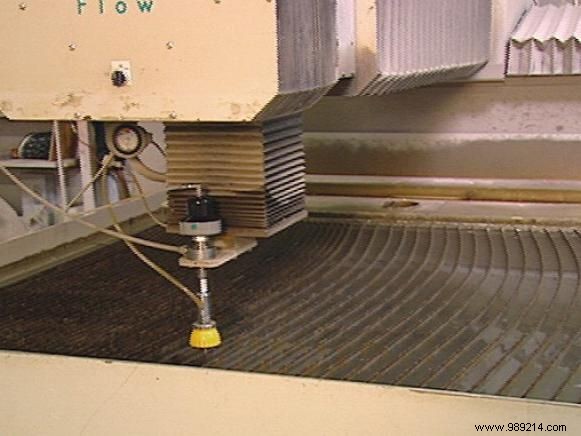
The welding process
The welding process was developed in the early 1940s for the aircraft industry. At Freeform Furniture a TIG (tungsten inert gas) welder was used. The TIG welder generates heat from an electrical arc between the electrode at the tip of the torch, the filler rod, and the metal part being welded. The electrode is made of tungsten. Tungsten is the same material in light bulbs, but instead of creating light, it creates heat—enough heat to melt metal. Basically, welding is the process of melting metal. There is also a ground cable that hooks onto the workpiece or welding table. It acts like the lightning rod on top of a building. It takes the excess electricity, conducts it through the cable to the frame of the welder and neutralizes it.
To create a strong weld, you don't want contaminants getting into the metal while it's in liquid form, as this will weaken the weld and cause cracks over time. Inert gases are gases that do not combine easily with other elements, such as metal. The inert gas, argon in the tank is pumped through the welder to the tip of the torch, where a small amount is released. This creates a gas shield around the weld that prevents contaminants from entering until the metal hardens.
TIG welders range in price from $1,000 to $3,500. The one from Freeform Furniture is about $2,800, but you can rent one from an industrial rental supply for about $60 a day and that includes safety gear.
Welding has its own inherent dangers. You are dealing with an electrical current that instantly generates 1,600 degrees of heat and a flash of light that is so bright it could blind you. A welding mask not only protects your eyes from the flash of light, but also covers your entire face and part of your neck. This is important because that bright light can burn you like sunburn. Protect your hands and arms with leather gloves and a long-sleeved leather welding jacket.
A great feature of the welder at Freeform Furniture is the remote amperage control that allows you to adjust the amount of heat while welding with a foot pedal.
The welding process consists of spot welding the metal parts, filling the weld, and finally cleaning the weld.
Tack Welds
The purpose of spot welding is to hold the parts of an assembly in proper alignment temporarily until the final welds are made. Although tack weld sizes are not specified, they are typically 1/2" to 3/4" in length, but never more than 1". When determining the size and number of tack welds for a specific job, you must consider the thickness of the metals being joined and the complexity of the object being assembled.
Place small tack welds on one side of the joint with the filler rod. When the solder cools, solder the other side of the joint. Spot welding involves welding two or more metal pieces together simply by applying pressure and heat to the area to be welded. Spot welding joins the two pieces of metal together using electrodes to send electrical current through the work pieces. Parts are heated locally. These small welds prevent the workpiece from overheating and warping until the permanent weld is made.
Fill welds
On freeform furniture, all joints were first spot welded and then fully welded and filled with the welding rod. Molten metal fills the space between the joint creating a strong weld, hence the name filler rod. The welds used here are technically called fillet welds:metal fused at a corner formed by two pieces of metal whose welded surfaces are approximately 90 degrees to each other. A fillet weld is very common in welded furniture. It is also one of the most difficult to weld consistently. Fillet welds require a high heat input. With beginning welders, this can lead to lack of penetration and/or fusion defects that cannot be detected visually.
Welding cleaning
After each weld, take a wire brush and clean the blue mark from the weld. This reduces the amount of polishing needed to remove discoloration later.
How to get your own Water-Jet Cut project
If you want to get your own waterjet cutting project, please make sure you have a technical drawing of the project. Go to the yellow pages. Any place that cuts steel or marble should have a water jet cutter. If there is nothing in your area, you can also consider laser cutting as an alternative.